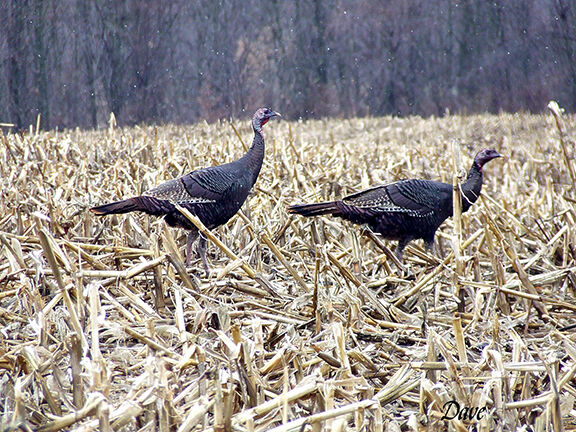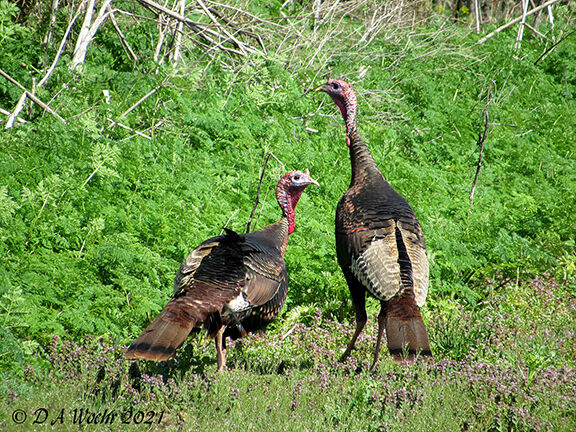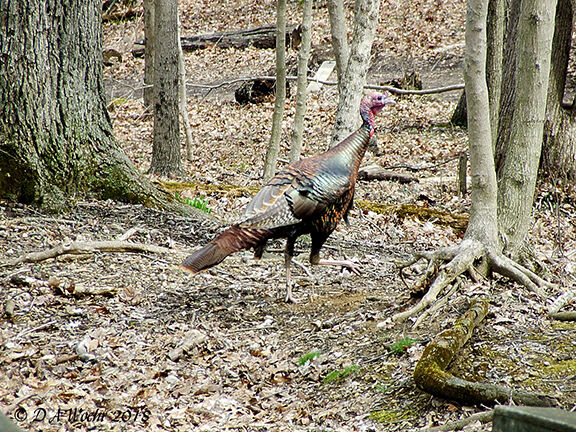Image

WARREN COUNTY, OH -- The Wild Turkey is indigenous to North America with a half dozen subspecies ranging from the Canadian border southward into Mexico and Central America. Ohio is home to the Eastern subspecies, which ranges from north to south across the US westward to the Great Plains.
 Some wild turkeys roaming an open field in Warren County
Some wild turkeys roaming an open field in Warren CountyAlthough turkeys do have natural predators such as bobcats, foxes, and raccoons, they are agile flyers and once airborne can make a clean getaway most of the time. Perhaps a bigger concern is nest predation by opossums, skunks, and snakes.
Turkeys nest on the ground where they usually lay 9 – 13 eggs in a location concealed by tree limbs, briars, vines, and other vegetation. As unlikely as it would seem for a 20+ pound bird, turkeys spend their nights roosting in large trees through most of the year. They just feel safer out of the reach of night-prowling critters on the ground that could do them harm.
 Like pheasants, quail, and grouse, turkeys do not migrate.
Like pheasants, quail, and grouse, turkeys do not migrate.The Wild Turkey population was well established throughout Ohio prior to the days of settlers moving westward. At that time, our state’s surface was more than 90% covered by forest. The turkeys had no difficulty finding acorns, beechnuts, berries, seeds, and insects to feed on in the forest. They also scratched the surface of the ground to uncover edible bulbs and roots of wildflowers and other small native plants.
In the 1800’s, however, the settlers cleared the state of all but 5% of its woodland, thereby destroying the habitat for turkeys and many other forms of native wildlife. The last native Ohio Wild Turkey was shot in Adams County in 1904. After that there were no Wild Turkeys in Ohio for the next 50 years.
Forests began to regenerate in the southern and eastern counties of the state in the early 1900’s as unproductive farmland was abandoned and human populations shifted from rural areas to the cities. Conservationists and state wildlife officials saw this as an opportunity to reintroduce the Wild Turkey to Ohio. Birds from several mid-western and southern states were trapped and released into Ohio’s second-growth forest in the mid-1950s.
The released birds fared well and are now established in all 88 Ohio counties. Like pheasants, quail, and grouse, turkeys do not migrate. Where adequate food and cover exist, they winter over just fine. Believe it or not, they have been seen in the City of Lebanon.
 After population growth, the turkey number are decling again.
After population growth, the turkey number are decling again.After more than 60 years of population growth in Ohio, the turkey flock is now declining area-wide. There are several likely causes for this, but cold, wet spring nesting weather resulting in poor hatches is a likely reason.
The Eastern Wild Turkey has been a popular game bird in Ohio for many decades. Presently, the Ohio Department of Natural Resources has reduced the hunter bag limit from two birds per year to one... hoping for an increase in turkeys in the years ahead.
To learn more about this species, visit page 9 of Ohio Division of Wildlife’s Common Birds of Ohio Field Guide.